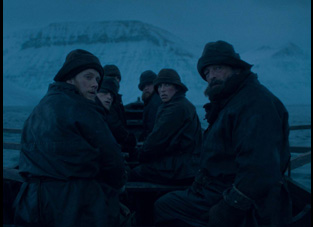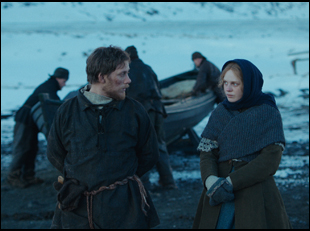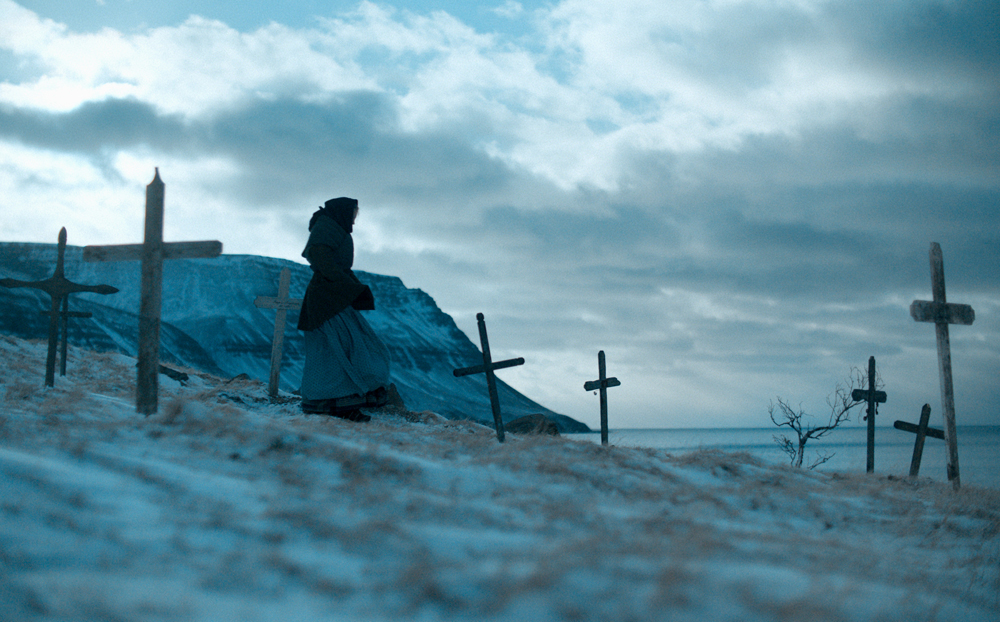“You drink deep when times are good and even deeper when they’re bad,” Ragnar (Joe Cole) tells Eva (Odessa Young) in “The Damned,” ready to take a big swig from a bottle as the two are huddled near a fire in the fishing station she owns on the Westfjords of Iceland. The winter can bring a great bounty for sailors like Ragnar, but as well-compensated as he is for bringing back fish to sell at market, the pay is also for enduring the bitter cold that accompanies the height of the season when they can be pulled from the sea, so the liquor is bound to provide a little warmth in a place where there’s little to be had and he’s found a drinking companion when there was a possibility she would’ve sold the pier this year, having lost her husband Magnus the previous one and stumbled into the unenviable position of being in charge of a business, overseeing a brusque group of surly fishermen, that she doesn’t have the experience to be confident about leading.
Neither operate from a position of strength in Thordur Palsson’s second feature, but the director does in mining their unique set of dire circumstances for suspense when it isn’t only the unforgiving climate conditions that are a threat to their safety, but a nagging sense that an ancient curse may be after them as well. The danger within may be less inexplicably supernatural than all too human as Ragnar’s fellow fishermen are frustrated by the limitations that Eva places on them as a form of protection when a more seasoned station owner might be a bit more flexible. But when they watch helplessly as another crew’s ship is capsized from afar as they’re on one of their expeditions with no such curbs in place, they are more angry than relieved at being unable to wade into deeper waters to mount a rescue and the potential for mutiny seems to run as high as the tides.
“The Damned” can explore the ugly side of humanity in various forms as characters make choices in the grip of their worst fears and there seems to be a fate worse than death as some thought not to make it in the water have a way of reemerging in a severely compromised form, giving no end to the terror that finds its way onto the shore. Although Palsson doesn’t shy away from the dark places the thriller seems destined to go, he embraces the beauty of the film’s snowy setting when the majesty of the mountains and the stir of the sea can be admired for their natural wonder and appear as an obstacle that would be foolhardy for anyone to take on and with compelling performances from Young and Cole as the youngest and most seemingly reasonable of anyone stranded at the fishing outpost staving off madness from setting in, the film navigates its own treacherous waters with impressive command.
Now with the film starting the spooky season early as it becomes one of the first to hit theaters in the new year, Palsson spoke about how the folk horror that surrounded him in his youth in Iceland led him to tell this story, making the cast and crew feel more comfortable in his home country than you’d imagine from what you see on screen and staying afloat during a difficult shoot.

There’s a big history of horror stories in Iceland, a very small, poor country [where] storytelling is a big part of the culture. So [this legend] has been in my family, which is this entity — it’s not quite what it would be translated today into English, [which is] a ghost, but back in the day, they had a different interpretation of what it is. It’s actually something that’s flesh and bone, a rotting corpse that comes back to seek revenge on the people that wronged them so greatly. That was a haunting image for me and then there’s this sad element of Icelandic history that there actually was a ship that sank off the shores of Iceland with the people from the Basque region. In real history, they were able to swim to shore, but when they got to shore, the poor farmers and the people that were trying to survive in this harsh place that Iceland is decided that they wanted the food and [supplies] they had on the ship, so they decided to kill all the Basque people. So [the film] is a mishmash of the ghost stories that I heard with the Icelandic history that I studied in school, but also working with the talented screenwriter Jamie Hannigan and my producers Emilie [Jouffroy] and Kamilla [Hodol].
There’s a great foundational element in having this young widow in charge of a fishing station predominantly populated by grizzled old sailors. Was that something you could find in the research?
That was always from the start. When you’re developing stories, it’s always how can you find a stranger that comes to town or this kind of fish out of water [situation]? You’re trying to find someone that is not from this place, doesn’t quite have the tools to do the things that are needed to be done, but she is very educated. She brings a pragmatism into the story that comes from a different place than the fishermen have, and usually these places are owned and run by men and it was run by her husband, but he died the year before in a fishing accident, so she is now stuck there with these smelly men, snowed in for the winter, trying to make the right decisions because now she is the person that they look to. Hopefully, the audience can argue about what they would have done in that situation.
From what I understand, it might’ve been a little more congenial on set in these cramped quarters than it appears on screen. How did you foster the atmosphere?
It is very important to try and get the cast and the crew and everyone together. I always remember Francis Ford Coppola talking about what he loves to do, and obviously I don’t have a vineyard in America, but I would love to. [laughs] But it was just getting everyone down there to Iceland, drinking wine and eating good food and when all the actors flew over, I made a point of getting all the actors together into this open-air museum that we have that has all of these period houses. That’s where we had our first read-through with all the actors around a table and everyone got to know each other. Then after that, we had to drive to the Westfjords, and that is a 10-hour drive and another chance for all of these people to be stuck in one place to get to know one another.
By the time we started shooting, everyone had gelled together and when you’re shooting a independent film in the middle of nowhere in the cold, you need the camaraderie to make it fun. We were very lucky that these people all gelled and were all friendly. Every weekend we did some activity and people ventured out of the town and went to the hot springs or swimming in the ocean. By the end, I’m pretty sure that they felt all quite sad to leave one another as the characters were picked off.
What was it like to design the film around the Westfjords as a location?
For me, the Westfjords is the most beautiful place in all of Iceland. I had lived there for a few months while I was writing a project, and it was always the place [where] you could point a camera and you’ll shoot some beautiful painting. It’s such a harsh and beautiful landscape and
the fishing culture is huge there. You get snowed in really easily over the winter and some of the fjords all are designed by someone — God, or Mother Earth — and it almost feels that there’s mountains in every direction. It’s not just behind you on both sides. It almost feels it’s also in front of you, so it’s this weird feeling of claustrophobia in this place.
How much could you use ambient light, whether it’s candlelight in the dark or that beautiful sun during the day?
Yeah, Eli Arenson, [our] cinematographer shot “Lamb,” and he has a great eye. From the beginning, we started talking about can this be lit by candlelight? Do we have to go full-on “Barry Lyndon”? So we did some tests and I’d say for 90 percent of the interiors we shot, they’re actually just lit by candlelight, so it was a great exercise in seeing what was possible and hopefully it adds to the feeling that people are really there. It doesn’t feel artificial. We were trying to design the sets, the costumes, and the lighting, so you were transported back to that time.

Anything to do with water takes quite a lot of time to do and is always a dangerous thing to do on such a tight budget, but we went full-on indie. We shot parts of things in the real ocean, but once characters had to fall in the ocean, we actually shot in an outside pool. You have so many characters falling into the water, and then you’ve got to go for another take, so we couldn’t really do that in the ocean. We were trying to figure out how to maneuver this and do as much in-camera as possible, but in the pool, we started to also have the complication of steam. So we just came up with the idea that it’s foggy [in the scene]. That was one of the logistically most difficult things to do in the film because of resets, time, actors getting wet, and you have to change the [clothing] and get them back in the boat, but a very important scene to have in the film.
You really feel the atmosphere, in part because of the sound design. What was it like mixing it?
Yeah, for me and Quentin [Collette], the sound designer, it’s very important to somehow put the audience in the shoes of the character. When you’re inside, you can hear the wind coming through the house, the creaking of the floorboards and outside when it’s freezing, you can feel that cold Atlantic air just getting inside your bones. So we’re trying to figure out how do you make an audience feel the cold? So obviously with the visuals, but also the sound design, it was very, very important to us to try and somehow get across how cold it is there.
What’s it been like to get this out into the world?
It took eight years from the initial idea to delivering the film, so to get to meet people that connected to the film, I just feel very blessed, [especially if] there’s a couple of thematic elements that they connect with, that it’s not just a fun genre [film], but [debate] the choices these characters make in the film maybe on the car ride home, about what you would have done or what I would have done. I’m just hoping that more people come to see it.
“The Damned” opens on January 3rd in wide release.




